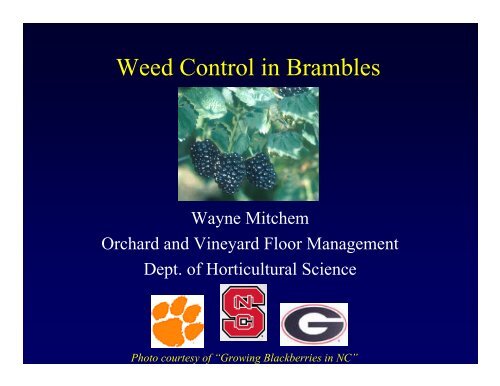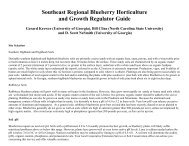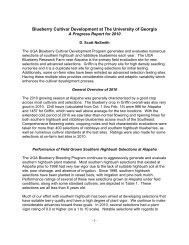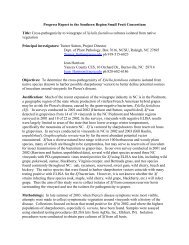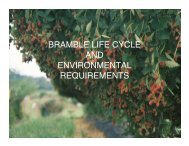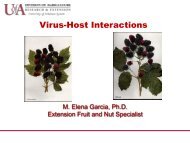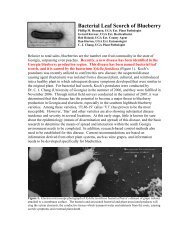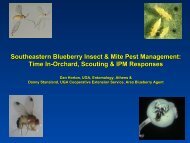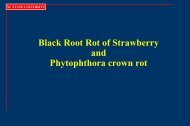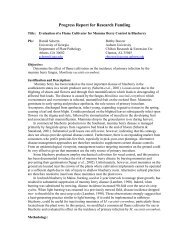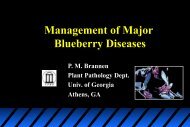Create successful ePaper yourself
Turn your PDF publications into a flip-book with our unique Google optimized e-Paper software.
<strong>Weed</strong> <strong>Control</strong> is Important• <strong>Weed</strong> control is important <strong>in</strong> establish<strong>in</strong>gand ma<strong>in</strong>ta<strong>in</strong><strong>in</strong>g a vigorous and highlyproductive blackberry plant<strong>in</strong>g. Hoe<strong>in</strong>g,shallow disk<strong>in</strong>g and herbicides arerecommended. S<strong>in</strong>ce blackberriesproduce shallow fleshy root systems,deep cultivation must be avoided.- Bramble Fact Sheet, Univ. of Florida
<strong>Weed</strong> Competition <strong>in</strong> Spr<strong>in</strong>g Planted RaspberriesTrt.WFCanes/plot151971 1972Avg.Ht.59Canes/plot71Avg.Ht.94WF 5/28+1425*5691WF 6/27+11*23*37 *74<strong>Weed</strong>y4*32*15*79H.M. Lawson and J.S. Wiseman. <strong>Weed</strong> Research, 1976, Vol. 16:155-162.
<strong>Weed</strong> Competition <strong>in</strong> Spr<strong>in</strong>g Planted RaspberriesTrt.Kg/plotFruit Yield Datag/caneg/100 cm caneWF1.2882140WF 5/28+0.26*20*77*WF 6/27+0.22*17*60 #<strong>Weed</strong>y0.06*15*41 $H.M. Lawson and J.S. Wiseman. <strong>Weed</strong> Research, 1976, Vol. 16:155-162.
Bramble Ground Cover Management• 4 ft weed-free band• Row middles or drivealley– Established sod– Annual cover crop– Native vegetationPhoto: “Commercial Bramble Culture”, Krewer et.al., UGA.
<strong>Weed</strong>-free Strip – How?• Mulch– Plastic (est. year)– Organic• Straw• Bark• Grass clipp<strong>in</strong>gsPhoto: “Bramble Opportunities” Slide Set, G<strong>in</strong>a FernandezPhoto: “Commercial Bramble Culture”, Krewer et.al., UGA.
<strong>Weed</strong>-free Strip – How?• Mulch Issues– Plastic (est. year)• Heat• Removal/<strong>in</strong>terference withcane development• Drip irrigation– Organic• Costs• Labor <strong>in</strong>tensive– Annual replacement• More suitable for smallarea?Photo: “Bramble Opportunities” Slide Set, G<strong>in</strong>a FernandezPhoto: “Commercial Bramble Culture”, Krewer et.al., UGA.
<strong>Weed</strong>-free Strip – How?• Herbicides– Injury (POST)– Hand removal may benecessary <strong>in</strong> some<strong>in</strong>stances– Cost effectivePhoto: “Commercial Bramble Culture”, Krewer et.al., UGA.
PRE Herbicide Options <strong>in</strong> NewlyPlanted <strong>Brambles</strong>• Devr<strong>in</strong>ol 50 DF – 4 lb/A– Activation with<strong>in</strong> 24 hrs is best• Oryzal<strong>in</strong> or Surflan – 2 to 4 qt/A– Activation with<strong>in</strong> 14 to 21 days– <strong>Control</strong>s annual grasses, pigweed,lambsquarters– DO NOT use on tissue culture plantsdur<strong>in</strong>g the first year.
PRE Herbicide Options <strong>in</strong> NewlyPlanted <strong>Brambles</strong>• Simaz<strong>in</strong>e 4F or 90DG – 1 qt or 1.1 lb/A– Activation with<strong>in</strong> 14 to 21 days– <strong>Control</strong>s ragweed, lambsquarters, pigweed, henbit,prickly lettuce, purslane, and annual grasses– DO NOT use on tissue culture plants the first yearof plant<strong>in</strong>g• Gallery 75 DF - .66 to 1.33 oz– Activation with<strong>in</strong> 21 days– <strong>Control</strong>s a number of broadleaf weeds; MGsuppression
• Solicam – 2.5 to 5 lb/APRE Herbicide OptionsEstablished <strong>Brambles</strong>– Dormant application– Weak on pigweed and lambsquarter– Excellent on annual grasses, prickly sida, dogfennel, spurge– Suppresses yellow and purple nutsedge– Activation with<strong>in</strong> 28 days; <strong>Brambles</strong> est. 12 mos.• Oryzal<strong>in</strong> or Surflan – 2 to 4 qt/A– Activation with<strong>in</strong> 14 to 21 days• Simaz<strong>in</strong>e 4F or 90DG – 2-4 qt or 2.2-4.4 lb/A– Even at higher rates the addition of Surflan will be necessaryfor maximum residual annual grass control.– Split application
PRE Herbicide OptionsEstablished <strong>Brambles</strong>• S<strong>in</strong>bar – 0.5 to 2 lb/A– Established plant<strong>in</strong>gs of 1 year or more– Apply <strong>in</strong> spr<strong>in</strong>g prior to fruit set– Do not apply with<strong>in</strong> 70 days of harvest– Do not use on sandy soils with less than 1% OM– Activation with<strong>in</strong> 14 days– <strong>Control</strong>s horseweed, pigweed, lambsquarters, annualmorn<strong>in</strong>gglory, ragweed, Florida pusley, annual grasses• Casoron 4G – 100 lb/A– Soil surface application may be applied <strong>in</strong> January– May be applied up until May 1 if <strong>in</strong>corporatedimmediately– Established plant<strong>in</strong>gs (1+ year)– <strong>Control</strong>s ragweed, dandelion, dogfennel, horseweed
POST Herbicide Options <strong>in</strong> <strong>Brambles</strong>• Gramoxone Max 1.5 to 2.7 pt/A– NIS @ 0.25 % v/v– Contact with new canes will cause <strong>in</strong>jury– May tank mix with PRE herbicides• Glyphosate – 11 to 32 oz/A or 1 to 3 pt/A– DO NOT ALLOW CONTACT WITH GREENCANES, BARK OR FOLIAGE– Apply as a directed shielded spray
Perennial <strong>Weed</strong> <strong>Control</strong> with Glyphosate<strong>Weed</strong> SpeciesBahiagrassBlackberrySmilaxNutsedge (y/p)Poison ivy/oakVirg<strong>in</strong>ia Creeper% v/v21-1.532-321.5-2Early HeadTim<strong>in</strong>gLate summer through early Dec.5 fully expanded leaves <strong>in</strong> spr<strong>in</strong>gFlower<strong>in</strong>g; use half rate andsequential applic. 3-4” tall plants.Two weeks either side of fullbloom (early summer)Late summer prior leaf colorchange
POST Herbicide Options <strong>in</strong> <strong>Brambles</strong>• Poast – 1.5 to 2.5 pt/A– COC @ 1 % v/v– 45 day PHI• Fusilade – 12 to 24 oz/A– COC @ 1% v/v– Nonbear<strong>in</strong>g use only• Select – 6 to 8 oz/A– NIS @ 0.25 % v/v– Nonbear<strong>in</strong>g use only
Bermudagrass <strong>Control</strong>• Poast @ 1.5 pt/A fb 1.0 pt/A– Apply when 4” new growthappear– Second application whenregrowth occurs• Fusilade @ 1.5 fb 1.0 pt/A– Application parameterssame as aboveInclude COC at 1% v/v (1 gal. Per 100 gal of spray solution)
Is Cultivation an Option?• 1 st Year after Plant<strong>in</strong>g– Shallow cultivation– Care must be taken to preventbreakage of emerg<strong>in</strong>g primocanes• Established Plant<strong>in</strong>gs– Cultivation promotes unwantedsucker<strong>in</strong>g– SHALLOW disk<strong>in</strong>g drive alley isacceptable
Crop AgeFallW<strong>in</strong>terSpr<strong>in</strong>gSummerNewlyPlantedGlyphosate(preplant)Oryzal<strong>in</strong> (Once soilsettles afterContact Infotransplant<strong>in</strong>g)Oryzal<strong>in</strong> + Paraquat(May or June);Fusilade, Poast, orSelect (as needed).Shallow cultivationmay be used as well.Glyphosate(preplant)Simaz<strong>in</strong>e (half rate) +Oryzal<strong>in</strong>Paraquat, Basagran,Fusilade, Poast, orSelect (as needed).Shallow cultivationmay be used as well.Glyphosate(preplant)Devr<strong>in</strong>ol (Once soilsettles aftertransplant<strong>in</strong>g)Paraquat, Basagran,or Fusilade, Poast, orSelect (as needed).Shallow cultivationmay used as well.Glyphosate(preplant)Gallery + Oryzal<strong>in</strong>Paraquat, Basagran,Fusilade, Poast, orSelect (as needed).Shallow cultivationmay be used as well.
Crop AgeFallW<strong>in</strong>terSpr<strong>in</strong>gSummerBlackberryandRaspberryEstablished1 or moreyearsSimaz<strong>in</strong>e +ParaquatSimaz<strong>in</strong>e +Solicam orOryzal<strong>in</strong> +ParaquatS<strong>in</strong>barParaquat (as needed);Fusilade, Poast, orSelect (as needed)Paraquat (as needed);Fusilade, Poast, orSelect (as needed)Simaz<strong>in</strong>e +ParaquatSimaz<strong>in</strong>e + Oryzal<strong>in</strong>or SolicamParaquat (as needed);Fusilade, Poast, orSelect (as needed)ParaquatCasoronParaquat (as needed);Fusilade, Poast, orSelect (as needed)
Contact InfoWayne Mitchem704-472-0770 (mobile)704-276-1584 (office/fax)Wayne_Mitchem@ncsu.edu


